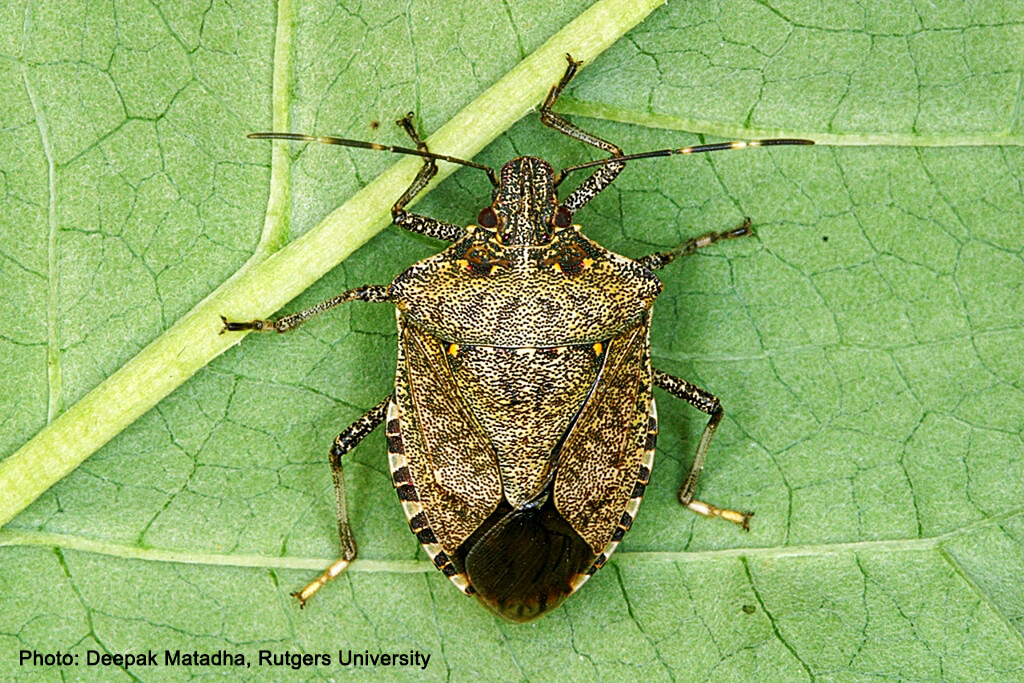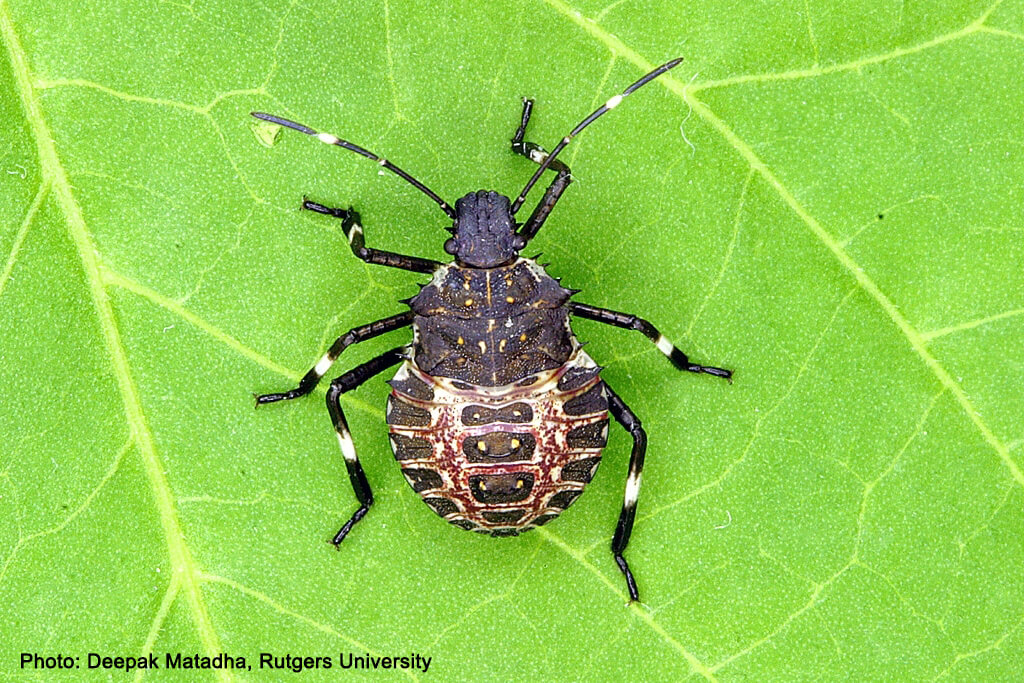February 15, 2011

Photo 1: Adult.
The brown marmorated stink bug really stinks!
By Jennifer Llewellyn
OMAFRA nursery crop specialist
and
Hannah Fraser
OMAFRA Entomology Program Lead - Horticulture
The Ontario nursery and landscape sector has had its fair share of introduced, invasive pests. It seems that every other year we are dealing with something new, and always scrambling to find out as much as we can about its identification, biology and management.
The relative quiet of 2010 has given some of us the chance to reflect on the past, and wonder about the future. What in the world is coming next?
There are more than a few potential problems on my mind, some of them being the hemlock woolly adelgid (Adelges tsugae), sudden oak death (Phytophthora ramorum) and a new pest on the radar, the brown marmorated stink bug (Halyomorpha halys). As of this writing, these pests have not been detected in Ontario, but we can’t help but worry that they might occur in the not-so-distant future.
The brown marmorated stink bug is native to Asia and was first detected in Pennsylvania in the late 1990s. It quickly spread into nearby Maryland, and is now found in 26 states and is expected to continue to colonize new territory.
The rapid spread of the pests can be attributed to its ability to walk over 100 metres, and also to hitch a ride on automobiles. This stink bug overwinters quite successfully in cold climates by congregating in artificial overwintering sites, such as polyhouses, greenhouses, homes and businesses.
Adult stink bugs have a shield-shaped body and measure 12 to 17 mm long. They have a needle-like beak that is used to suck plant sap. We have several species of stink bugs in Ontario; some of them are brown. How do you determine if it’s a brown marmorated stink bug? It’s challenging, but not impossible. The most reliable means are the antennae. The antennae of the brown marmorated stink bug have white bands on the last two segments, the segments nearest the tip (Photo 1). The Asian stink bug also has white bands on the legs and the edges of the abdomen have a checker pattern, but so do some of the other brown stink bugs already established in Ontario.
The immature nymphs of stink bugs look a little different than the adult, since the nymphs gradually develop shield-shaped wings over a matter of weeks. This may make them difficult to recognize at first. However, the nymphs of the brown marmorated stink bug will bear those diagnostic white bands on their antennae (Photo 2). The nymphs also have a reddish-black abdomen that is more striking in the younger stages where wing buds are quite reduced.
The brown marmorated stink bug is bad news. It feeds on the fruit of several commercially important crops such as peaches, apples, pears, grapes and raspberries. Even with weekly insecticide applications, U.S. growers are finding fruit losses in the neighbourhood of 20-50 per cent. There are even reports of losses to soybeans, sweet corn and field vegetable crops.
 Photo 2: Nymph.
Photo 2: Nymph.
Stink bugs have an extremely wide host range and can be found feeding on several ornamental species in outdoor production and home gardens as well. The Asian stink bug has been found causing feeding injury on outdoor grown herbaceous crops and cut flowers, such as chrysanthemum and sunflower. The pests will feed on the fruit of ornamental trees (e.g. crabapples), but they will also suck sap from the twigs and leaves of woody plants as well. Some of the ornamental host species include: roses, dogwood, apple, lilac, catalpa, viburnum and many, many more.
Integrated Pest Management programs for the brown marmorated stink bug have been largely unsuccessful in many areas of the U. S. This has a lot to do with the mobility of the nymph and adult life stages and the fact that many of the newer, reduced risk insecticides are not effective. New populations of stink bugs will arrive in a crop almost weekly, which requires regular spraying of more persistent insecticides. Researchers are actively seeking alternative means of managing this insect, including light traps and pheromone traps. Black light traps are reported to attract this species of stink bug quite effectively. The University of Maryland reports that the lights can be used both as a monitoring and as a management tool, especially when coupled with a vacuuming device.
Oh, and the brown marmorated stink bug really does stink. “Quite a bit,” according to entomologists who routinely work with other members of the stink bug family. Both female and male marmorated stink bugs have special glands to emit a strong, repulsive odour that is used as a defence mechanism. As you can imagine, the odour is magnified when they congregate to overwinter in a heated structure, like your house. Nice.
Jennifer Llewellyn may be reached at 519-824-4120, ext. 52671, or by email jennifer.llewellyn@ontario.ca.
OMAFRA nursery crop specialist
and
Hannah Fraser
OMAFRA Entomology Program Lead - Horticulture
The Ontario nursery and landscape sector has had its fair share of introduced, invasive pests. It seems that every other year we are dealing with something new, and always scrambling to find out as much as we can about its identification, biology and management.
The relative quiet of 2010 has given some of us the chance to reflect on the past, and wonder about the future. What in the world is coming next?
There are more than a few potential problems on my mind, some of them being the hemlock woolly adelgid (Adelges tsugae), sudden oak death (Phytophthora ramorum) and a new pest on the radar, the brown marmorated stink bug (Halyomorpha halys). As of this writing, these pests have not been detected in Ontario, but we can’t help but worry that they might occur in the not-so-distant future.
The brown marmorated stink bug is native to Asia and was first detected in Pennsylvania in the late 1990s. It quickly spread into nearby Maryland, and is now found in 26 states and is expected to continue to colonize new territory.
The rapid spread of the pests can be attributed to its ability to walk over 100 metres, and also to hitch a ride on automobiles. This stink bug overwinters quite successfully in cold climates by congregating in artificial overwintering sites, such as polyhouses, greenhouses, homes and businesses.
Adult stink bugs have a shield-shaped body and measure 12 to 17 mm long. They have a needle-like beak that is used to suck plant sap. We have several species of stink bugs in Ontario; some of them are brown. How do you determine if it’s a brown marmorated stink bug? It’s challenging, but not impossible. The most reliable means are the antennae. The antennae of the brown marmorated stink bug have white bands on the last two segments, the segments nearest the tip (Photo 1). The Asian stink bug also has white bands on the legs and the edges of the abdomen have a checker pattern, but so do some of the other brown stink bugs already established in Ontario.
The immature nymphs of stink bugs look a little different than the adult, since the nymphs gradually develop shield-shaped wings over a matter of weeks. This may make them difficult to recognize at first. However, the nymphs of the brown marmorated stink bug will bear those diagnostic white bands on their antennae (Photo 2). The nymphs also have a reddish-black abdomen that is more striking in the younger stages where wing buds are quite reduced.
The brown marmorated stink bug is bad news. It feeds on the fruit of several commercially important crops such as peaches, apples, pears, grapes and raspberries. Even with weekly insecticide applications, U.S. growers are finding fruit losses in the neighbourhood of 20-50 per cent. There are even reports of losses to soybeans, sweet corn and field vegetable crops.
 Photo 2: Nymph.
Photo 2: Nymph.
Stink bugs have an extremely wide host range and can be found feeding on several ornamental species in outdoor production and home gardens as well. The Asian stink bug has been found causing feeding injury on outdoor grown herbaceous crops and cut flowers, such as chrysanthemum and sunflower. The pests will feed on the fruit of ornamental trees (e.g. crabapples), but they will also suck sap from the twigs and leaves of woody plants as well. Some of the ornamental host species include: roses, dogwood, apple, lilac, catalpa, viburnum and many, many more.
Integrated Pest Management programs for the brown marmorated stink bug have been largely unsuccessful in many areas of the U. S. This has a lot to do with the mobility of the nymph and adult life stages and the fact that many of the newer, reduced risk insecticides are not effective. New populations of stink bugs will arrive in a crop almost weekly, which requires regular spraying of more persistent insecticides. Researchers are actively seeking alternative means of managing this insect, including light traps and pheromone traps. Black light traps are reported to attract this species of stink bug quite effectively. The University of Maryland reports that the lights can be used both as a monitoring and as a management tool, especially when coupled with a vacuuming device.
Oh, and the brown marmorated stink bug really does stink. “Quite a bit,” according to entomologists who routinely work with other members of the stink bug family. Both female and male marmorated stink bugs have special glands to emit a strong, repulsive odour that is used as a defence mechanism. As you can imagine, the odour is magnified when they congregate to overwinter in a heated structure, like your house. Nice.
Jennifer Llewellyn may be reached at 519-824-4120, ext. 52671, or by email jennifer.llewellyn@ontario.ca.